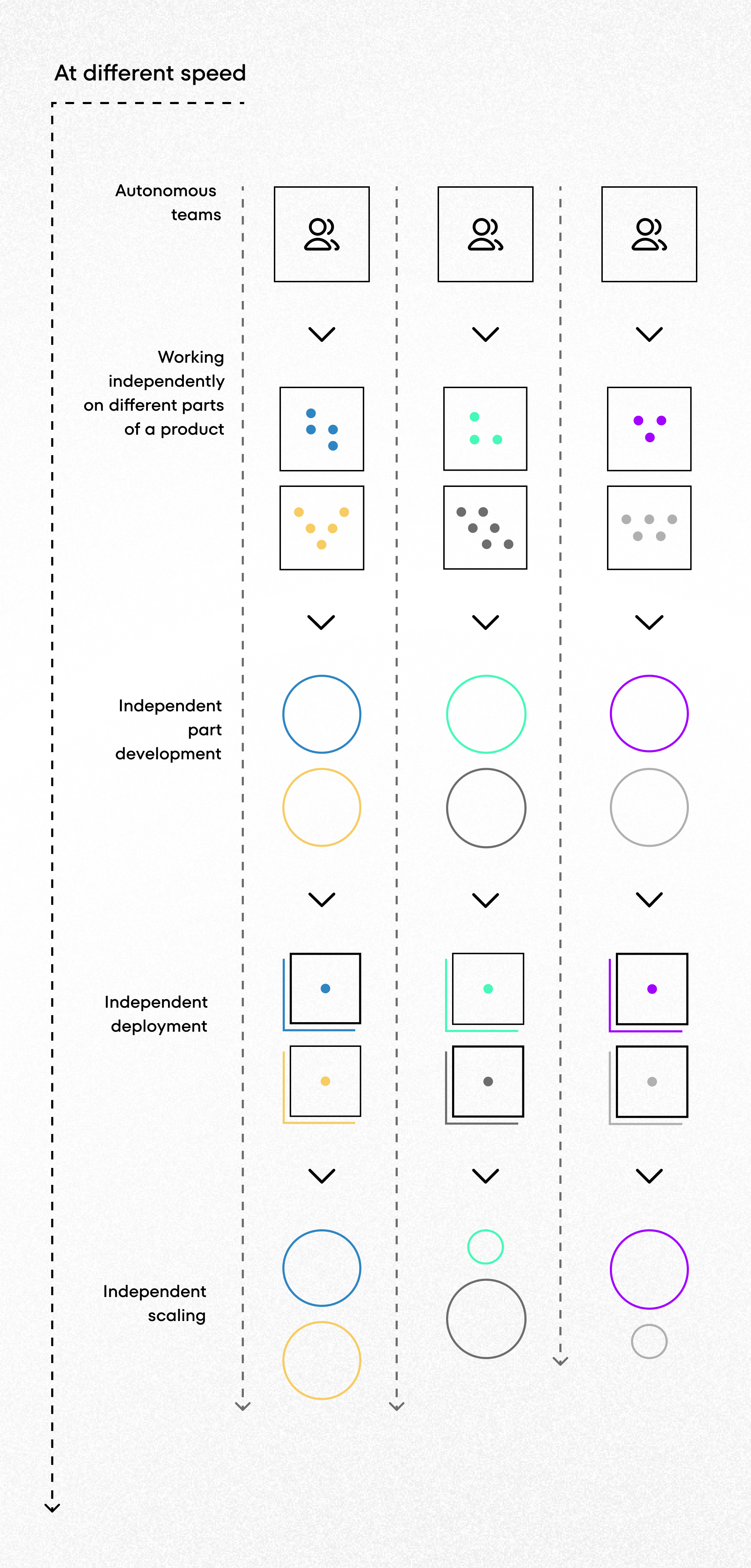May 20th, 2019 | by Adam Maciejek
How Can Startups Scale Business Through Microservices and Processes?

Table of contents
Startups have one goal – deliver and optimize solutions that provide customer value. As quickly as possible. The mentality allows for mistakes (testing for market response) but not the lack of delivery. Especially when it comes to software – new and updated technologies, and constantly changing market variables makes it nearly impossible to keep up. That’s why rapid software development solutions and microservices are the way to go. We developed one of them.
By focusing on the primary goal of every conscious entrepreneur, which is customer value, startups free up resources to do pretty much everything else. When we invest time and focus on the hardest part, the rest falls out into place, making our work faster and smoother. Here are 5 tips on how to scale your startup without sacrificing quality.
1. Divide your organization into smaller teams
Love is not the only thing that multiplies when divided, knowledge is another one. When people work in smaller teams, they develop a natural tendency to care more. The level of responsibility is higher, therefore the need for the team to succeed, grows exponentially. That’s why people share knowledge.
Smaller teams let the work flow more naturally, therefore the bigger tasks are completed faster and more efficiently.
2. Build cross-functional teams
Cross-functionality means that the team has all the necessary skills needed to turn a Product Backlog into a fully done increment. By organizing a team this way, your company is able to handle multiple projects at once or a large one, making steady increments in a sprint.
By putting on team members with different background, competencies (design, development, testing) and experience, you assure not only an even contribution across the field by multiple points of view. By making teams small you don’t risk chaos, these contributions will be contained by a team leader, not letting things go out of hand. Cross-functionality equals efficiency.
Naturally, you can aim for team members to have T-shaped personalities (one core specialization plus lower level of competencies across the board) but that is a compromise.
3. Released and viable
When it comes to delivery, there is no simpler philosophy than that. Your product has to be viable and you should release it when it has the minimum level of functionality to be viable. That’s it, the rest is a learning curve with the feedback from clients, end-users, and investors.
By following a culture of the minimum viable product, you’ll soon learn that less is more. Adding fewer functionalities to products saves time and lets you test the idea before it’s matured. It’s perfect for risky ideas and great for rapid proof of concept development. You also have the ability to quick learning, offered by less costly mistakes. When you do have a proof that idea works, then it’s a reasonable but present race to the time-to-market finish line.
4. Focus on challenges, nothing else
Since the product has to be viable at the early stage, it has to be built around the actual challenge. It can be a user need, a manufacturer production problem, business owner management issue, etc. Whatever the case may be, even the proof-of-concept requires a certain level of advancement. To achieve it, ground your work in the real-life challenge, don’t drift in the unnecessary direction.
The very core of the application should not only fix the client’s problem or deliver the most wanted functionality but do it in the cleanest way possible. We will talk about speed and efficiency right now.
5. Build with microservices and rapid software development solutions
Outsourcing programming services and dedicated platforms for rapid software development are good when you need help. Other things not so much – you have to love the ‘conventional wisdom’ phrase. People know that… Years of experience show… No, they sometimes don’t, period. Conventional wisdom says that you have to build a monolith application, not a modular one, with microservices running things in the background, expanding not only architectural possibilities but also options for the user.
By founding an application on microservices, you invite end-users to utilize its capabilities actively. A monolithic structure on any application limits it and damages not only popularity (if it’s destined for the consumer market) but also the ability to quickly respond to changes in production (industrial use). A classic monolith application stands on three legs: a database, a client-side user interface, and a server-side application. Its characteristics also consist of a massive codebase which consists of server-side application logic, front-end client-side logic, background tasks, etc. – all defined in the same code base.
Yes, this kind of architecture has its pros:
- Less operational overhead
- Performance
- Easy testing
- Less cross-cutting concerns in comparison to microservices
There are some cons as well:
- Overly-tight coupling
- Requires much more effort to understand and maximize potential
In comparison, microservices are more agile than monoliths. You can develop a single application as a suite of small services rather than developing them as one product. Each individual service runs on its own process, communicating with lightweight mechanisms (that also free up resources), usually with an HTTP-based API. Microservices are independently deployable and at the same time can work in pairs or in groups, if necessary.
Pros of microservices:
- Performance
- Hypothesis-driven design and development
- Easy recomposition and reconfiguration
- Hard cross-walk between different part of the system (hard to mess things up)
- Technology heterogeneity. Every microservice can be paired up with different technology stack that better suits its needs (both functional and non-functional)
- Native support for cloud-based solutions
- High resilience – an application can function even if some part fails due to problems with internet communication or server downtime
- Organizational alignment
- Composability
Yes, there are some cons:
- Higher operational overhead
- Possibility of cross-cutting across services
Surely you have found that we put ‘performance’ in the pros of each category. It’s not a coincidence; under right circumstances, both variants can be beneficial. Monolith applications use local calls instead of API calls. On the other hand, with microservices, you can isolate hot services and scale them independently from the rest of the application.


Microservices have also two, rarely discussed major advantages:
- They allow using multiple technologies to produce different parts of the application. If your API is highly optimized at the lowest level in let’s say, C++, then using the language for anything else is like shooting a sparrow with the cannon
- Multiple technologies equal multiple talents in your company. Having highly qualified and diverse stuff creates a brand for your company. Furthermore, it brings new people on board, interested in the vast in-house technology landscape
Rapid software development solutions are affordable
Since the birth of the term ‘microservices’ in 2012, executives worry about not only technological advancement but also costs. I can achieve my goals, but will I go broke – they say. The answer to this statement is simple ‘no’. It’s called MAKO and it’s microservices-based.
MAKO is a rapid software development platform, built by CSHARK. It’s a backbone for your application, allowing you to deliver value faster and more reliable. How does it work exactly?
Imagine that you have a building plot, fully armed. You have running water, gas, electricity and so on. You also have building foundations. Strong but flexible, like modern buildings in Japan. They can bend, responding to outside force and adjust to circumstances but they won’t break. This is MAKO in a nutshell. We provide all the necessary tools, the rest is up to you. You can create any kind of application, industry-based or else, without worrying about costs, proofing time and so on. MAKO saves even 12 months of development. That’s real money.
If you want to know more about rapid software development solutions, contact us, and start developing!


